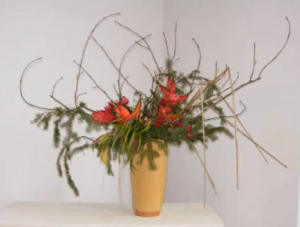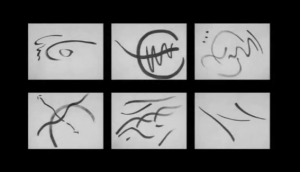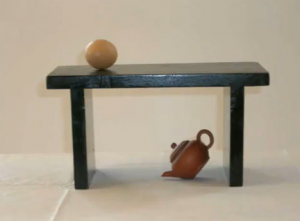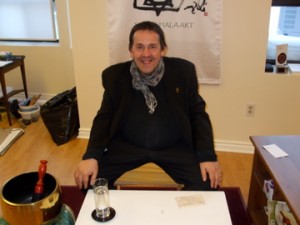Wednesday
Arts and Poetry, Atlantic CanadaMeeting up with sacredness: an interview with Stéphane Bédard
“Magic lies in the state of mind of the artist. This magic is wakeful magic. The artist’s mind is able to tune in to a certain balance or wakefulness – we could call it enlightenment in fact.” Chogyam Trungpa Rinpoche
ST – Good morning Stéphane, I am pleased that the Shambhala Times could join itself to the 10th year anniversary celebrations of the Shambhala Art path in Ottawa.
Can you tell us about your experience of the Dharma Art and Ikebana teachings?
SB – I’ve been directing Shambhala Art: Awakening the Sacred since the fall of 1997, that is, since the program was launched. I first taught it in Montréal for two years, and then I moved to Ottawa. As for Ikebana, I have been practicing and teaching this art for a long time under the guidance of our venerable teacher, Watanabe Sensei who, for her part, has been teaching it since 1957. Every time I direct a Shambhala Art weekend, I go to the woods to cut branches for an arrangement that I create in the room where the program will occur. It is part of my preparation. I go meet the dralas in nature: they pacify me. Then I create the ikebana: another way of awakening the sacred, of invoking the dralas. This is all done in silence and contributes to create the proper atmosphere.
ST – How did these teachings begin in Ottawa?
SB – I first held a few open houses before I had gathered sufficient participants to offer a Part I. In Ottawa, we offer the program over two days: Saturday and Sunday from 9-6. In the beginning, participants were mostly members of the Centre and we usually had 8-12 participants. I was immediately struck by their vulnerability and their courage: in these types of programs people open up and reveal themselve s. Often, the various exercises—be they object arrangement, installations, calligraphy, movement, collage, poetry, space awareness, ikebana, painting, etc.—invoke a degree of authenticity that is immediately touching, with no need for explanation, beyond any conceptualization. There are moments of grace where the basic goodness of each person is celebrated: carefully gazing at participants’ collages, calligraphies or poems, you penetrate each time into a new universe and discover unsuspected qualities. There needs to be an atmosphere of gentleness; the feminine principle must be manifest in these workshops. A lot of space, of open mind. You don’t teach dharma art, says Trungpa, you create an atmosphere in which it can arise.
Over the years, I have been fortunate to be supported by a few remarkable people who help me a lot. Friendly and effective, they understand the sacred nature of this work. There is much to do in a very short time. It is a continual practice of mindfulness in action where everyone must be precise in support of others. The staff does everything it can so that participants feel welcome, including breakfasts and teas. And they also joyfully participate in all the exercises. They are creators who enjoy meeting people in an atmosphere of meditation in action, where the dignity of each person enriches the discussions that follow the short talks. Because teachings are presented: it’s not about doing one exercise after the other in order to be really proud of your calligraphy or poem. The entire program is based on the nine yanas of Tibetan Buddhism. Sitting meditation sessions are short. The focus is on meditation in action. We present teachings that help participants discover the nature of creativity and how to make a work of art out of their lives. There are five weekends and Parts IV and V focus on vajrayana teachings principles.
ST – What is the future of these teachings in Ottawa?
SB – This year we are celebrating our 10th anniversary in this city where we have offered on average 5-6 workshops every year, not counting open houses. To mark the event, we have produced a video using photographs from workshops dating back to 2004. We hope to make a longer film next year.
In 2009, we offered a workshop in the Department of Visual Arts at the University of Ottawa. Some 15 students and professors participated and learned how to meditate in this setting. The participants greatly appreciated these teachings. Some even said that these courses should be part of the university curriculum. Keep posted.
ST – What impact had Trungpa Rinpoche on your life? And in your way to teach?
SB – Having been privileged for more than two decades to translate Rinpoche’s work into French, including the Dharma Art book, and doing a Ph.D. thesis on translating his work, my relationship with this great teacher is very close. It’s not easy to translate a mahasiddha: best to practice, study, teach the dharma a lot and know very well the translator’s trade. In directing Shambhala art workshops, I literally discovered another aspect of his genius. Shambhala Art allows us to reveal concretely the basic goodness that every human being possesses. Trungpa understood that neither Buddhism nor the Shambhala teachings would take root in the West unless this wisdom was also integrated into all forms of art. What can be more dignified than to express one’s joy or sadness through an art form? Art invites non-aggression, establishes peace and celebrates all basic goodnesses. It helps to transcend all “ism’s”. Trungpa loved artists. Through this cycle of teachings, he offers them essential teachings to develop their practice and attain enlightenment.
When I teach, Trungpa fills my heart. Sometimes, I feel as if he is whispering the teachings to me. After all, we belong to the “ear whispering lineage”. Very helpful when you have to communicate the work of a Buddha.
ST – How do these teachings influence life in the Ottawa Shambhala Centre?
Last fall, we received Lady Diana, Chogyam Trungpa’s widow, who came to speak about enlightened society. Many non-members were attracted to the Centre by this. We decided to have them experience enlightened society, in particular, through two Shambhala Art sessions because art has the power of bringing people together in a non-conceptual manner without the usual conventions. Among other things, they wrote poems on the theme of enlightened society, created an installation and did collages that they put up on the walls, according to a particular ritual. Within two days, the meditation hall was progressively transformed into an impromptu art gallery. We celebrated an enlightened society in the here and now.
In general, I have noticed that people are very grateful at the end of Shambhala Art weekends, often more so than after other activities of practice and study. This is because the work accomplished in two days as well as the richness and singularity always expressed by participants touches them deeply. They see that it is not always necessary to be a professional artist to express themselves genuinely. Everyone can attend these workshops where there are people who, otherwise, would never come to the Centre if they were not given the opportunity to practice artistic disciplines.
And why offer Shambhala Art: Awakening the Sacred in a meditation Centre or elsewhere? The creativity, the happiness that these teachings bring are essential in a Centre, in the city, in life.
[kml_flashembed movie="http://www.youtube.com/v/5lcvJOdXbO0" width="425" height="350" wmode="transparent" /]
Student of Chogyam Trungpa Rinpoche, Stéphane Bédard practices, studies and teaches dharma in Canada and United States, since 1978. Stéphane has translated from English to French, books by Chogyam Trungpa Rinpoche, Pema Chodron, Jeremy Hayward and the Sakyong Mipham Rinpoche.
Ikebana master, he animates Dharma Art workshops within the Shambhala Art: Awakening the Sacred curriculum. Established in Ottawa, he is an expert translator for the Canadian Cultural Affairs, where he practices this trade for the now last 30 years.
Thank you to Suzanne Côté, who kindly translated this interview originally in French.





















Dec 25, 2012
Reply
Hi Stéphane,
liked to read your interview.
You maybe remember me, I was your guest for a month or so in 1984.
Living meanwhile in Ulm, Germany.
Into music, painting besides other things.
Sharing an apartement with friends.
Would like to read from you.
Albrecht
Jun 29, 2009
Reply
Great interview. Stephane has done amazing work in establishing Shambhala Art in Canada. He has been an inspiration to other teachers. I wish him the best in the years to come.